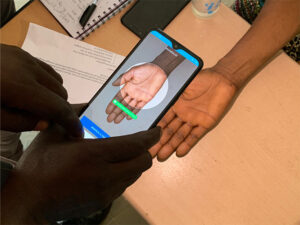Strengthening the fight against tuberculosis: how digital identity can improve healthcare access

Every year on 24 March, the world observes World Tuberculosis (TB) Day, a critical moment to raise awareness about this preventable and curable disease. Despite significant medical advancements, TB remains one of the world’s deadliest infectious diseases, particularly affecting vulnerable populations with limited access to healthcare. At Simprints, we believe that innovative solutions, like biometric digital identity, can play a crucial role in ensuring that TB patients receive the care they need.
The challenge: identifying and treating TB patients
One of the biggest barriers in the fight against TB is patient identification. Many at-risk individuals live in remote areas with weak healthcare infrastructure, lack official identification, or struggle to consistently access medical services. Tracking diagnosis, treatment adherence, and health outcomes becomes exceedingly difficult without reliable patient records. As a result, millions of TB cases go undetected, and many patients do not complete their full course of treatment, leading to drug-resistant TB strains and higher mortality rates.
How digital identity can help
Biometric digital identity solutions, like those developed by Simprints, offer a transformative approach to tackling these challenges. By using fingerprint or facial recognition technology, healthcare providers can securely and accurately identify patients at every stage of their TB journey. Here’s how:
- Improved diagnosis and case management
Digital identity ensures that individuals are correctly identified when seeking TB diagnosis, reducing the risk of duplicate or missing records. This allows for better case management and ensures continuity of care. - Ensuring treatment adherence
TB treatment requires months of medication adherence. By linking each patient to their health record biometrically, healthcare workers can track visits, monitor adherence, and provide timely interventions if a patient misses doses. - Reaching the hardest-to-reach
Many TB patients lack formal ID, making access to government healthcare programs difficult. Biometric identity provides a simple, inclusive solution that works even in remote settings without the need for paper documents. - Generating reliable data for better policies
Accurate patient identification leads to better health data. Governments and organisations can use this data to understand TB trends, allocate resources efficiently, and strengthen national TB programs.
Statistics
- Fingerprint tracking reduced TB treatment default rates by 25% in urban India.1
- A fingerprint system deployed by the CDC (Centre for Disease Control and Prevention) in Haiti, Zambia, and the Dominican Republic, enrolled 200,000+ patients and performed over 1 million identification matches for accurate TB patient tracking.2
- A fingerprint tracking program in India reduced the MDR-TB treatment default rate to below 1.5%, compared to ~3% before its implementation.3
Simprints in action

Simprints has worked alongside global health partners to integrate biometric identity solutions into TB care programs. In partnership with frontline health workers, our technology is helping to improve TB case detection and treatment adherence, ensuring that no patient is left behind.
A call to action
This World TB Day, we reaffirm our commitment to leveraging technology for a world free of TB. But the fight requires collective action. Governments, NGOs, and healthcare providers must continue to embrace digital innovation to improve TB care. By strengthening health systems with biometric digital identity, we can move closer to ending TB once and for all.
Join us in this mission. Together, we can ensure that everyone, everywhere, has access to life-saving TB care.
References


